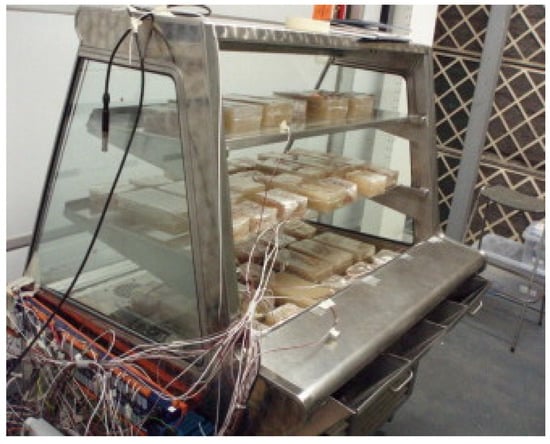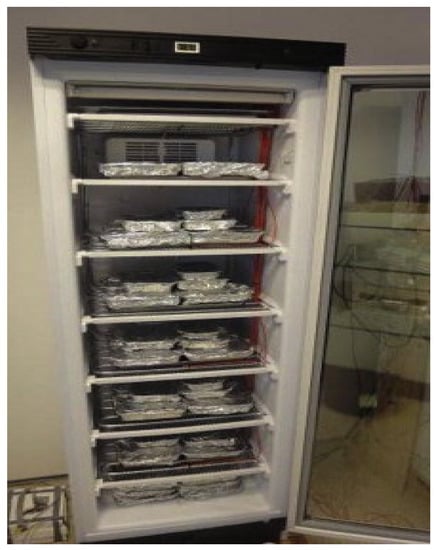You're using an outdated browser. Please upgrade to a modern browser for the best experience.
Please note this is a comparison between Version 1 by Pedro D. Gaspar and Version 3 by Dean Liu.
Appropriate measures have been taken to reduce energy requirements for cold chain applications. Thermal energy storage is an accepted method to reduce the need for electrical energy after harvesting fresh horticultural produce. The use of phase change materials (PCM) in postharvest storage, outside of a temperature-controlled environment, extends shelf life and keeps food at the ideal temperature.
- cold chain app
- thermal energy storage
- phase change materials
1. Introduction
Unexpected temperature fluctuations or disruptions in the food cold chain can affect food safety and quality, leading to a loss of consumer confidence and an increase in food waste. Reportedly, about one-third of the world’s food production is wasted each year [1][2][1,2]. Much of these losses are due to poor post-harvest handling, lack of proper facilities, and inadequate cold chain training of workers. Cold chain issues have been studied and reviewed over the past decade [3][4][5][3,4,5]. Due to inefficient management, about 30% of all food is wasted worldwide. More than half of all harvested fruits and vegetables are lost due to poor thermal management during storage [6][7][6,7]. It is estimated that more than CAD 25 billion worth of food is wasted in Canada each year, or about 2% of Canada’s GDP. Global food losses vary widely by region, with higher losses in countries such as China, where only 15% of fresh produce is shipped refrigerated, even though this food must be refrigerated [8]. In 2012, the total cost of food waste in the EU-28 was estimated at EUR 143 billion. A temperature rise of 10 °C increases the spoilage rate by 2–3 times in a short period of time if fruits are improperly handled after harvest [9]. To improve the quality of food, it is important to maintain the temperature during storage and transportation, as this helps to reduce waste. Food cold chain applications account for approximately 8% of global electricity, contributing to an increase in fossil fuel consumption and 2.5% of global carbon emissions [10]. Recently, several researchers have worked to improve the efficiency of cold storage by optimizing the stacking pattern, position, and ventilation of packages [11][12][13][14][15][16][17][18][11,12,13,14,15,16,17,18]. However, these studies only decrease the energy consumption during storage without considering thermal conditions throughout the cold chain. Produce quality must be maintained throughout the cold chain, i.e., during storage, transportation, and post-harvest retail display. Produce is stored at optimal temperature but must be transported from harvest to storage chambers, and after storage it must be delivered to customers, with transportation playing a critical role in maintaining optimal temperature. Food is transported from ports and airports through a network of nearly 4 million vehicles around the world, and maintaining a controlled environment is not feasible because containers are exposed to adverse environmental conditions [19]. Poor post-harvest handling results in unacceptable food quality and causes microbial rot, spoiled products, and maximum losses due to food waste [3]. Thermal energy storage is one of the most promising methods used to overcome the mismatch between supply and demand in energy distribution in cold chain logistics. The overall energy consumption decreases and efficiency are improved by using PCM for thermal energy storage in various applications such as transportation [20][21][22][23][20,21,22,23], showcases [24][25][26][24,25,26], household refrigerators [27][28][29][30][31][32][33][27,28,29,30,31,32,33], and buildings [34][35][36][34,35,36]. During the process of solidification and melting, cans store and release a large amount of energy in the form of latent heat. This phenomenon improves the energy management working during peak load conditions for optimum storage [37]. The management of thermal energy storage approaches usually are classified into deterministic (considering no uncertainty) and robust/stochastic (dealing with uncertainty) [38][39][38,39]. RThesearchers aim aim of this review paper is to investigate the use of PCM in various applications, mainly related to cold storage.
Some of the researchers worked on PCM reviews related to cold chains [40][41][42][43][44][45][40,41,42,43,44,45]. Rostami et al. [40] carried out a review of properties of nano PCM and work mainly focused on solar energy storage. A review by Taher et al. [41] was mainly focused on the PCM in refrigerated trucks. Sarkar et al. [42] investigated packaging structures in cold stores using PCM. Nie et al. [43], Oró et al. [44] and Pielichowska et al. [45] reviewed all applications from solar building to textiles and their properties. Although many researchers have studied the use of PCM and its thermal properties, they are mainly concerned with the chemical properties of PCM and its encapsulation methods. ReThisearchers paper mainly focuses on the cold storage of perishable goods in cold chain logistics, specifically on low-temperature applications, such as refrigerated transportation, refrigerated display cases, and packaging. In addition, the use of CFD is widely used in research to predict thermal behavior.
2. Applications of PCM
Over the years, a number of researchers have looked at PCM in various applications, with most of the work related to buildings [46][47][48][49][50][51][54,55,56,57,58,59], domestic refrigeration [52][53][54][60,61,62], and solar panels [54][55][56][57][62,63,64,65]. RThesearcher current work focuses on post-harvest storage of perishable products, and therefore mainly considers cooling in cold chains. Using PCM in the cold chain not only maintains the optimal thermal condition of the products, but also improves the efficiency of cold storage [36][43][36,43].2.1. PCM in Packaging and Display Cabinets
In order to provide consumers with high-quality products after harvest, the cold chain is essential. The design of appropriate packaging ensures product quality at all stages of storage, transportation, and sale to consumers. The temperature of perishable products must be maintained within certain limits to provide high-quality products [58][66]. To mitigate the temperature rise, packaging can be designed with insulated containers, PCM, and modified atmosphere packaging (MAP) and stored on refrigerated shelves, as shown in Figure 13 [53][61]. PCM are used in freezers to protect products at optimal temperature during power outages and to reduce energy consumption by reducing the duty cycle of the compressor.PCM with thermal insulated materials provides a reduction in energy consumption in cold chain logistics [53].
PCM with thermal insulated materials provides a reduction in energy consumption in cold chain logistics [61].
Marques et al. [53][61] studied the temperature stabilization of food display cases in the temperature range of 0 °C to 5 °C and found that the addition of nucleating agents (AgI) with water-preserved products is better during power outages and frequent opening of doors.



